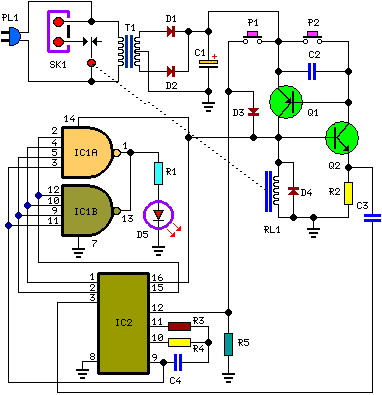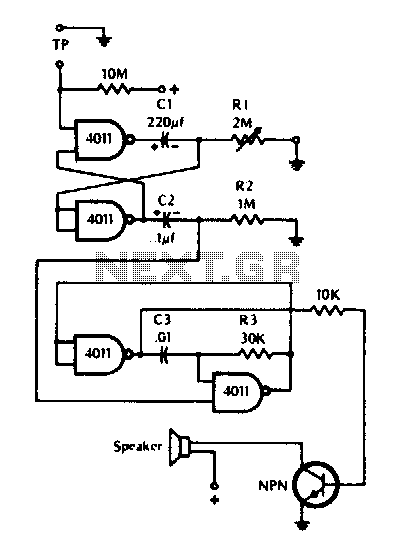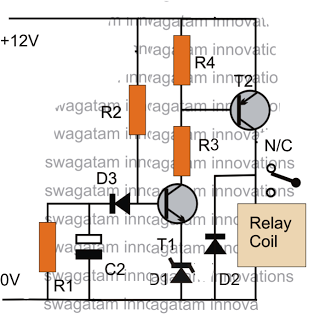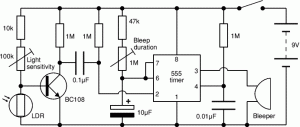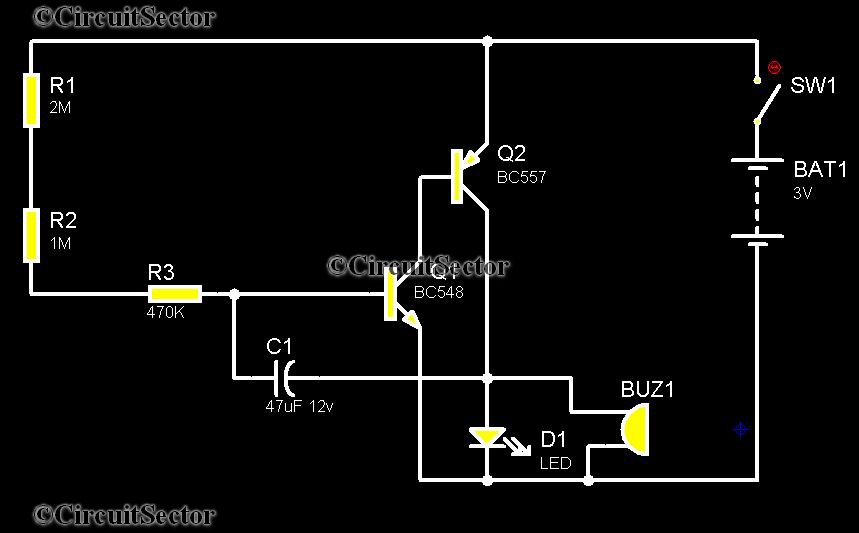
Long Duration Timer
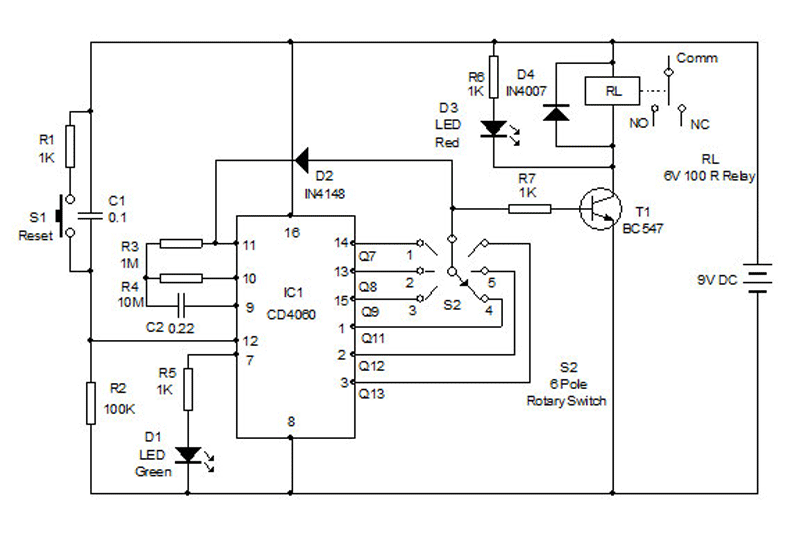
This timer can provide a time delay ranging from 10 minutes to 12 hours. The time delay is adjustable via a rotary switch, and upon completion of the timing cycle, a relay is energized and remains latched until the circuit is reset. This circuit has various applications, including battery charging and controlling laboratory equipment. The timing cycle is not highly precise, and a variation of one to three minutes can be expected. The main component of the circuit is the popular binary counter IC CD4060, which serves as a 14-stage oscillator, binary counter, and frequency divider with an integrated oscillator that operates based on the resistor connected to pin 10 and the capacitor connected to pin 9. When the timing cycle is complete, the output of the IC goes high, which can be used to drive loads such as a relay through a driver transistor. As the CD4060 is a binary counter, each output turns high with a time delay that is double that of the previous output and remains high for the same duration. Therefore, any of the 10 outputs can be utilized to achieve the desired time delay. Output Q10 is omitted in the IC, resulting in the time delay of Q11 (pin 1) being four times longer than that of Q9 (pin 15). Upon power-up, IC1 resets through capacitor C1 and resistor R2, initiating oscillations. The output Q3 (pin 7) activates first, indicated by the blinking of a green LED. Each subsequent output turns high in sequence. When an output goes high, transistor T1 conducts and activates the relay. A load can be connected through the common and normally closed (NC) contacts of the relay, ensuring that when the relay is energized, the load is disconnected. A red LED indicates the relay's activation. When an output goes high, diode D2 conducts, inhibiting the oscillator, and IC1 latches with a high output, keeping the relay energized until a reset occurs. A push switch can be used to reset IC1 if necessary. The circuit is powered by a 9-volt DC supply.
The timer circuit utilizes the CD4060 IC to achieve an adjustable timing function through a combination of resistors and capacitors that determine the oscillation frequency. The rotary switch allows users to select the desired time delay, which is crucial for applications requiring precise control over timing. The binary counter nature of the CD4060 means that as each output is activated, the timing intervals increase exponentially, allowing for a wide range of time delays with minimal component changes.
The relay used in the circuit must be suitable for the load being controlled, with consideration given to the current and voltage ratings. The driver transistor (T1) should be chosen based on the relay's coil current requirements, ensuring that it can handle the load without overheating or failing. Additionally, the use of diodes (such as D2) is critical for protecting the circuit from back EMF generated by the relay coil when it is de-energized.
The inclusion of indicator LEDs (green for timing and red for relay activation) provides visual feedback to the user, enhancing the usability of the circuit. The reset functionality, facilitated by the push switch, allows for easy reinitialization of the timer, making the circuit adaptable for repeated use in various applications.
Overall, this timer circuit design offers a reliable and flexible solution for time delay applications, with the potential to be further customized based on specific user requirements or load characteristics.This Timer can give a time delay from 10 minutes to 12 hours. The time delay can be selected using a Rotary switch and when the timing cycle completes, relay energizes and remains latched till the circuit resets. This circuit finds various applications like battery charging or to control lab equipments. Timing cycle is not so precise and a variati on of one to 3 minutes can be expected. Main element of the circuit is the popular Binary counter IC CD4060. It is the 14 stage Oscillator cum binary counter cum frequency divider with an inbuilt oscillator which oscillate depending on the values of the resistor connected to its pin 10 and capacitor at pin 9. When the timing cycles completes, output of the IC goes high. This output can be used to drive loads such as relay through a driver transistor. Since IC 4060 is a binary counter, each output turns high with a time delay double that of the previous one and remains high for the same duration.
So any of the 10 outputs can be used to get the required time delay. Output Q 10 is omitted in the IC itself so that the time delay of Q11 (Pin 1) output is 4 times higher than that of Q9 (Pin 15). At power on IC1 resets through C1 and R2 and starts oscillations. Q3 output (Pin7) turns high first which is indicated by the blinking of Green LED. Each output then turns high as follows: When the output turns high, transistor T1 conducts and activates the relay.
Load can be connected through the Common and NC contacts of the relay so that when the relay turns on, load disconnects. Red LED indicates the activation of relay. When the output turns high, diode D2 conducts and inhibits the oscillator and IC1 latches with the high output and the relay remains energized till resetting.
Push switch can be used to reset IC1 if required. Circuit can be powered using 9 volt DC. 🔗 External reference
The timer circuit utilizes the CD4060 IC to achieve an adjustable timing function through a combination of resistors and capacitors that determine the oscillation frequency. The rotary switch allows users to select the desired time delay, which is crucial for applications requiring precise control over timing. The binary counter nature of the CD4060 means that as each output is activated, the timing intervals increase exponentially, allowing for a wide range of time delays with minimal component changes.
The relay used in the circuit must be suitable for the load being controlled, with consideration given to the current and voltage ratings. The driver transistor (T1) should be chosen based on the relay's coil current requirements, ensuring that it can handle the load without overheating or failing. Additionally, the use of diodes (such as D2) is critical for protecting the circuit from back EMF generated by the relay coil when it is de-energized.
The inclusion of indicator LEDs (green for timing and red for relay activation) provides visual feedback to the user, enhancing the usability of the circuit. The reset functionality, facilitated by the push switch, allows for easy reinitialization of the timer, making the circuit adaptable for repeated use in various applications.
Overall, this timer circuit design offers a reliable and flexible solution for time delay applications, with the potential to be further customized based on specific user requirements or load characteristics.This Timer can give a time delay from 10 minutes to 12 hours. The time delay can be selected using a Rotary switch and when the timing cycle completes, relay energizes and remains latched till the circuit resets. This circuit finds various applications like battery charging or to control lab equipments. Timing cycle is not so precise and a variati on of one to 3 minutes can be expected. Main element of the circuit is the popular Binary counter IC CD4060. It is the 14 stage Oscillator cum binary counter cum frequency divider with an inbuilt oscillator which oscillate depending on the values of the resistor connected to its pin 10 and capacitor at pin 9. When the timing cycles completes, output of the IC goes high. This output can be used to drive loads such as relay through a driver transistor. Since IC 4060 is a binary counter, each output turns high with a time delay double that of the previous one and remains high for the same duration.
So any of the 10 outputs can be used to get the required time delay. Output Q 10 is omitted in the IC itself so that the time delay of Q11 (Pin 1) output is 4 times higher than that of Q9 (Pin 15). At power on IC1 resets through C1 and R2 and starts oscillations. Q3 output (Pin7) turns high first which is indicated by the blinking of Green LED. Each output then turns high as follows: When the output turns high, transistor T1 conducts and activates the relay.
Load can be connected through the Common and NC contacts of the relay so that when the relay turns on, load disconnects. Red LED indicates the activation of relay. When the output turns high, diode D2 conducts and inhibits the oscillator and IC1 latches with the high output and the relay remains energized till resetting.
Push switch can be used to reset IC1 if required. Circuit can be powered using 9 volt DC. 🔗 External reference
